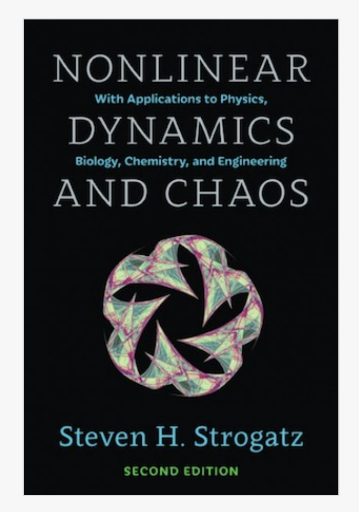MAM2046W - Second year nonlinear dynamics
MAM2046W - Second year nonlinear dynamics
Section 0.0: Course Introduction
Section 0.0: Course Introduction
Department of Maths and Applied Maths - University of Cape Town
If you find any mistakes, or have comments on the notes, please message me at jon.shock@gmail.com.
This is the second year course which follows the first year course, MAM1043H. Notes for MAM1043H can be found here. The next couple of paragraphs are the same as those in the previous course.
You do not need to get it. I will aim for this all to be self-contained. However, it is a beautifully written book, and almost certainly
the best introduction to the subject.
Here are some more links to online courses which you may want to browse.
Here are some more links to online courses which you may want to browse.
Please note, that I will often put in links to Wikipedia articles. One has to be careful about how accurate Wikipedia pages are, and in general if you are writing a scientific research paper, Wikipedia articles are not good to reference. However, for an educational set of notes like this, where I think that it will add useful content, I will be doing so. Wikipedia articles should be read with a critical hat on, and if you want to dig further, look at the references in the articles themselves.
What is this course about?1) Understanding what a dynamical system is through examples and definitions2) Knowing how to write down the mathematics of a dynamical system through examples and problems2) Knowing how to understand the interactions of dynamical systems through quantitative and qualitative means through many different techniques
I am writing these notes using the Wolfram Mathematica programming language. It means that I can very easily include nice plots and animations which should add to the content. You do not need to know how to use this.
The Course Content:
Section 1: Two dimensional nonlinear systems (Strogatz chapter 6)
Section 2: Limit cycles (Strogatz chapter 7)
2.6 Exercises for part 2
Section 3: Bifurcations (Strogatz chapter 8)
Section 3: Bifurcations (Strogatz chapter 8)
Section 4: Chaos (Strogatz chapter 9)
Section 4: Chaos (Strogatz chapter 9)
4.1 The Lorenz equations and chaos on a Strange Attractor 4.2 The Lorenz map 4.3 Exercises for part 4
Section 5: One dimensional maps (Strogatz chapter 10)
Section 5: One dimensional maps (Strogatz chapter 10)
5.1 The logistic map 5.2 Lyapunov exponents 5.3 Hénon maps (Chapter 12) 5.4 Exercises for part 5
Section 6: Fractals (Strogatz chapter 11)
Section 6: Fractals (Strogatz chapter 11)
6.1 TBD
Chapter 0: Reminder
Chapter 0: Reminder
We started off last year talking about differential equations where we had a single function, of the form:
and we found that there was some interesting phenomena to discover even in this very simple setting. However, there were a number of things which we proved could not happen, for instance you can’t have oscillations in a one dimensional system (remembering that if we add in time dependence this is equivalent to looking at a two dimensional system).
Where
This plot alone will help us a lot when we move on in the next section to the non-linear case.

